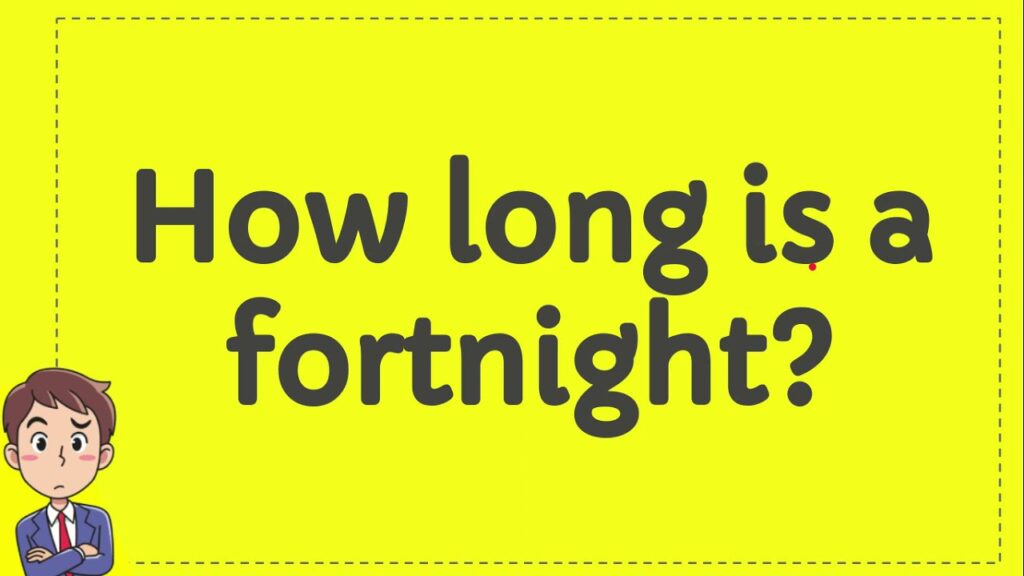How Long is a Fortnight? A Comprehensive Guide
Introduction
In today’s fast-paced world, where time is of the essence, it’s easy to forget about the more traditional units of time measurement. One such unit is the fortnight, a term that is not as commonly used as it once was. In this comprehensive guide, we will explore the history, definition, and usage of the fortnight, as well as its relevance in modern times.
What is a Fortnight?
A fortnight is a unit of time that is equal to two weeks or 14 days. The word “fortnight” is derived from the Old English word “feorwertyne niht,” which means “fourteen nights.” This term has been in use since the 900s and has its roots in the Anglo-Saxon period.
History of the Fortnight
The concept of a fortnight has been around for centuries, with various civilizations using similar units of time measurement. In ancient Rome, for example, the term “quinquatrus” was used to refer to a period of five days, while the term “nundinae” was used to refer to a period of nine days.In medieval Europe, the fortnight was commonly used for various purposes, such as rent payments, court sessions, and market days. The term was also used in the military to refer to the period between paydays.
Usage of the Fortnight
Today, the fortnight is still used in various contexts, although its usage has declined in recent years. Here are some examples of how the fortnight is used:
- Rent and Mortgage Payments: In some countries, rent and mortgage payments are still made on a fortnightly basis.
- Payroll: Some employers pay their employees on a fortnightly basis.
- Sports Leagues: In some sports leagues, such as the Australian Football League (AFL), the term “fortnight” is used to refer to a two-week period between matches.
- Literature: The term “fortnight” is still used in literature, particularly in historical novels and period pieces.
Relevance in Modern Times
In today’s world, where time is measured in seconds and minutes, the fortnight may seem like an outdated and irrelevant unit of time measurement. However, there are still some contexts in which the fortnight remains relevant:
- Tradition and Culture: In some cultures and traditions, the fortnight is still used as a unit of time measurement, particularly in rural areas or among older generations.
- Nostalgia: For some people, the fortnight represents a simpler time when life moved at a slower pace. The term can evoke feelings of nostalgia and a longing for a bygone era.
- Uniqueness: Using the term “fortnight” can add a touch of uniqueness and quirkiness to one’s writing or speech, particularly in formal or academic contexts.
FAQs
Q: How many days are in a fortnight?
A: A fortnight is equal to 14 days or two weeks.
Q: What is the origin of the word “fortnight”?
A: The word “fortnight” is derived from the Old English word “feorwertyne niht,” which means “fourteen nights.”
Q: Is the fortnight still used today?
A: Yes, the fortnight is still used in various contexts, such as rent and mortgage payments, payroll, and sports leagues. However, its usage has declined in recent years
Q: Why is the fortnight relevant in modern times?
A: The fortnight remains relevant in modern times due to tradition, culture, nostalgia, and uniqueness. It can also add a touch of quirkiness to one’s writing or speech.
Q: Is the fortnight used in other languages?
A: Yes, similar units of time measurement exist in other languages. For example, the French term “quinzaine” refers to a period of two weeks or 15 days.
Q: Can the fortnight be used in a sentence?
A: Yes, here are a few examples:
- “The rent is due every fortnight.”
- “The team will have a two-week break before their next match.”
- “In a fortnight’s time, we will be celebrating our anniversary.”
Table of Information
| Characteristic | Description |
|---|---|
| Definition | A fortnight is a unit of time that is equal to two weeks or 14 days. |
| Origin | The word “fortnight” is derived from the Old English word “feorwertyne niht,” which means “fourteen nights.” |
| Historical Usage | In medieval Europe, the fortnight was commonly used for various purposes, such as rent payments, court sessions, and market days. |
| Modern Usage | Today, the fortnight is still used in various contexts, such as rent and mortgage payments, payroll, and sports leagues. |
| Relevance in Modern Times | The fortnight remains relevant in modern times due to tradition, culture, nostalgia, and uniqueness. |
| Similar Units in Other Languages | The French term “quinzaine” refers to a period of two weeks or 15 days. |
| Example Sentences | “The rent is due every fortnight.” “The team will have a two-week break before their next match.” “In a fortnight’s time, we will be celebrating our anniversary.” |
Additional Resource
This comprehensive guide provides a detailed overview of the fortnight, including its history, definition, usage, and relevance in modern times.



